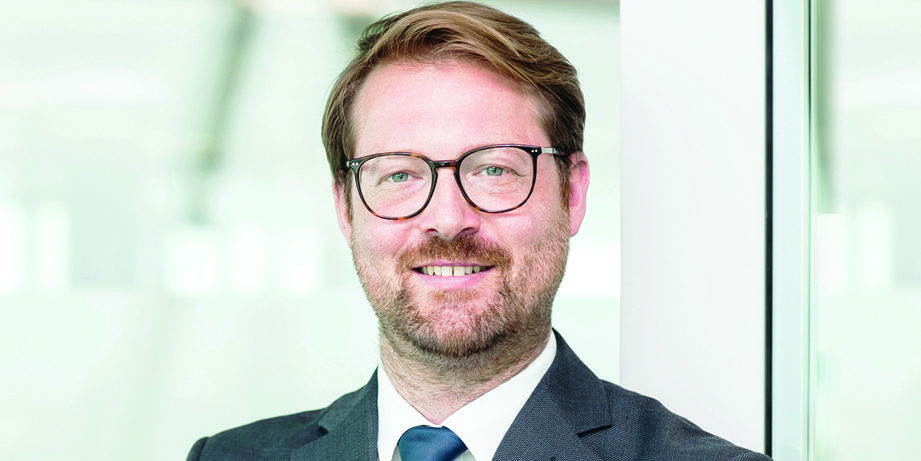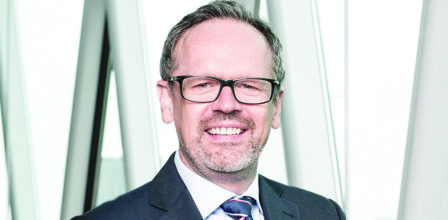Interview with CTO Dr Alexander Beck: Technology at a quantitative asset manager
As a quantitative asset manager, we translate scientific theory into mathematical and computer models that guide our trading and portfolios. The Technology division has the important task of creating the space for these models to be developed and operated. Data management plays an important role here. In conversation with our Chief Technology Officer, Dr Alexander Beck.

You are the first person to be appointed as Chief Technology Officer at Quoniam. Can you tell us a bit more about your role? Why did Quoniam create this position?
Especially as a quantitative asset manager, our work is naturally dependent on a solid technological foundation. Therefore, technology expertise is an integral part of our company purpose and deeply rooted in our DNA. As we all know, IT and technology are constantly and sometimes rapidly evolving, and so attention at management level is needed to stay ahead of the curve – which is how my role came about. As CTO, it is my job to identify strategically relevant technology issues and to address and build them in such a way that we secure our competitive technological advantage in the long term. For example, our access to data and our data management must be efficient and of high quality, but process efficiency and process automation are also very important for us. This requires appropriate software technologies, infrastructure and the right culture and mindset.
When you started at Quoniam, what was your most important goal?
First of all, of course, it was important for me to get a good overview of the state of our system landscape and software development and to develop an agenda from there: Where do we want to go in the next few years and what additional topics do we need to address that were perhaps new to the company at the time. The first big task was not long after I took up my post: thanks to Corona, almost the entire company moved completely into the home office overnight, which had actually been the exception for Quoniam until then. Although our digital working environment was basically suitable for mobile working thanks to virtualisation solutions, there was still a lot to do to further optimise digital collaboration.
“We live in a world where many companies want to work more data-driven. This is nothing new for us. Data is part of our production line at every point. Making our products measurable in metrics such as alpha or in ESG aspects is core to our DNA.”

Dr. Alexander Beck
Chief Technology Officer
What are the particularities of working in the technology area of a financial services provider compared to other industries?
The main difference from my point of view is that we, as financial service providers, are heavily regulated in IT by the supervisory authorities. But on balance, this also has advantages: When it comes to new topics and system introductions, we are careful from the beginning to consider important topics such as security concepts and data protection in addition to the right tools and computing power. We are therefore perhaps sometimes slower compared to a less regulated industrial company, which can develop a little more according to the motto “just do it”. Of course, this approach is also what the big American software companies promote through their cloud offerings.
We, on the other hand, work on our technological development right at the beginning with more care and diligence in order to have regulatory conformity at the end. This means that we don’t always have quite as many degrees of freedom, but once we have reached our goal, we can be sure that our solutions and developments will endure. By the way, we also work intensively with external experts on this. This in turn benefits our employees in terms of a steep learning curve. One example is the development of the Microsoft Azure Cloud. In this project, in addition to technical concepts and component selection, we also worked out questions about IT regulation, which is still uncharted territory for many financial institutions today. The whole project became a bit bigger, but in the end the solution was tailored exactly to our needs as a financial institution.
Is technology drier at a financial services provider than in other sectors? And what is the error culture like in such an environment?
I wouldn’t call our technology dry at all, but rather well thought-out and designed for the long term. The way we work offers more than enough room for a good error culture. We also need this in order to constantly develop and drive innovation forward; the opposite would be fatal for us. The crucial thing is to deal with mistakes in a positive and solution-oriented way – preferably in such a way that we can all learn from them. Sometimes IT regulation is a bit dry when it comes to test routines and the like. But here, too, we can be innovative and introduce modern technologies and automation solutions that take us further.
“Our systems must be easily scalable – for example, in our research cloud we have the option of using several hundred computing cores in parallel for a single task. This shows the potential of going down the path to the cloud.”

Dr. Alexander Beck
Chief Technology Officer
What is special about working in the technology area of a quantitative asset manager?
What distinguishes us as quantitative asset managers is that our work is scientific, data-driven and model-driven. Put simply, we translate scientific theory into mathematical and computer-based models that ultimately guide our trading and our portfolios. In Technology, we have the important task of creating the space for these models to be developed and operated. Data management has an important function here. Data availability and quality are important success factors for us. This means that our systems must be easily scalable – for example, in our research cloud we have the option of using several hundred computing cores in parallel for a single task. This shows you what kind of power is behind it when you go down the path to the cloud. It makes a huge difference whether I wait a week for my results in research or just an hour. When results are quick, the work is more fun.
What role does data play in this?
We live in a world where many companies want to work more data-driven and increase the level of automation. This is nothing new for us. Data is part of our production line at every point. Making our products measurable in metrics such as alpha, risk or in ESG aspects is core to our DNA. One example is the UN Sustainable Development Goals: These are 17 goals, each with several sub-goals, which adds up to a lot of data points. For us, it is relatively easy to integrate this into an investment approach because we are data-driven anyway.
What successes have you been able to achieve in the area of technology in recent months?
In the last few months, we have created a modern and mobile digital workplace for our employees and have done valuable conceptual work to make our investment platform fit for the future. Another big success is the development of our research cloud platform, where we jumped straight into the deep end and initiated a big change. Our research platform comes from a world where we used the software SAS on PCs sitting under our desks. This setup no longer stands up to the new requirements around data onboarding and machine learning and therefore had to be renewed.
“The cloud is like a candy shop for technology experts. Many roads lead to Rome. In the end, it is not so important to find the very best way, but: What matters to us is a very good path, which we then pursue stringently and successfully.”

Dr. Alexander Beck
Chief Technology Officer
What exactly did we do to modernise the research platform?
First, we agreed on open source and the Python programming language, where the essential innovation in data technologies and data modelling is happening these days. We proclaimed Python as a strategic programming language for the entire company, to allow business and developers to work seamlessly on the same technology. Because as a technology-driven company, we naturally want to have a powerful setup here, for example by also enabling the portfolio managers to develop portfolio ideas quickly and independently with Python. The decision for Python opens up a huge cosmos of methodological possibilities, but is also well suited for data processing and prototyping as well as for productive development. And Python fits with our new cloud architecture. In addition, we built the Research Cloud from the outset to be scalable and well thought out in terms of IT regulation. This will allow us to connect other technology areas at Quoniam to this setup in the future.
What were your most important learnings from this project?
The leap into the cloud was the right decision and we had a highly motivated project team as well as the right experts on board. My most important learning at the end was the importance of constant re-focusing. The cloud is like a candy shop for technology experts. It’s a fine line between unlimited trial and error and making directional decisions that we then strictly adhere to so as not to drag out substantive progress. Many roads lead to Rome and in the end, it is not so important to find the very best way with a lot of effort, but: What matters to us is a very good path, which we then pursue stringently and successfully.
What’s on your agenda for the next two to three years?
Quoniam is experiencing a bit of a tidal shift right now. We are putting key issue areas behind us – the creation of modern workplace equipment is largely complete and it is really nice to see that we have arrived in the new digital working world. However, there are still two big issues ahead of us: Firstly, the modernisation of our IT regulatory framework, which will keep us very busy in the next few years, and, secondly: that after the research cloud, we will also modernise our investment platform from the ground up, raising the very important topic of data management to a best-in-class level. Process automation will also be used here: for example, a portfolio managers should come to their workplaces in the morning and already have optimised portfolios available. The portfolio should then perhaps even provide recommendations for action, where further expert actions are pending and required. In such work-flows, a lot of preparatory work can be done through technology and thus the work of the portfolio manager can be focused on where they have the most important added value: Bringing in creativity and expertise instead of struggling with systems.
Can you elaborate a bit on the topic of digital working?
We have developed and rolled out a concept for hybrid working for our Frankfurt and London locations as well as equipping our employees with state-of-the-art mobile IT infrastructure. The mix of working in the office and mobile working at home or on the road is thus possible even more smoothly. Docking stations at every desk have made us more flexible in the office and could also easily implement hot-desk concepts in the future. We deliberately opted for laptops with touchscreens and matching pens to better enable hybrid work and digital note-taking. So that, for example, you can spontaneously open a digital whiteboard in a meeting and sketch your own ideas to the audience – we all know how helpful it is sometimes to put a short sketch on paper to organise thoughts. What is very important when it comes to hybrid collaboration is that we remain curious, open to new technical possibilities and share them transparently.
In the past months, many colleagues have mainly worked from home, the exchange in the office was limited. What do you think will happen next?
In the future, of course, there will be more hybrid meetings, where some colleagues will be at home and others will be in the office. The transition will be more fluid and it shouldn’t matter whether you are at home or not – at the same time, colleagues in the office should be able to take advantage of the face-to-face exchange. We are well prepared and have the digital possibilities to be flexible here – but want to further strengthen this digital competence at our company.
What is your opinion on the topic of presence culture vs. 100% home office?
In principle, it is important and good to leave as much freedom as possible. But too much flexibility can also jeopardise creative exchange. There are some companies that had a 100% home office philosophy and then took it back – Yahoo, for example. I am in favour of a hybrid approach that allows mobile work flexibly, but also sees personal exchange as an important factor for creativity and innovation. It is important that the basic mood and motivation in the company is right and that people look forward to seeing their colleagues. After all, the workplace is an enormously important social environment. Only recently I had a great discussion situation in the office, which came about spontaneously and where more and more colleagues joined in over time. We questioned together: Are we talking about the same thing? Do we have the same goal? This probing is important to reinforce each other that everyone wants the same thing. And if you find disagreements, it is possible to talk about them in an uncomplicated way and without an appointment. It can be little things like “I’m still waiting for an email from you” to “exciting lecture in three weeks, is that something for you?” We all can’t read more emails and have more meetings – we need the ease of quick, spontaneous exchange much more again. What will also be important in the future: creating occasions to work in the office – at Quoniam we have a game console, meet at the breakfast buffet and eat cake together for birthdays. But even more important than these incentives is strengthening the personal responsibility of all employees and developing a sense of belonging in each individual.
Thank you very much for the interesting interview!


